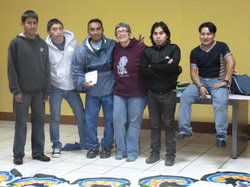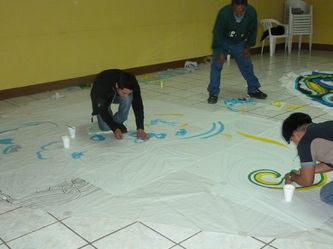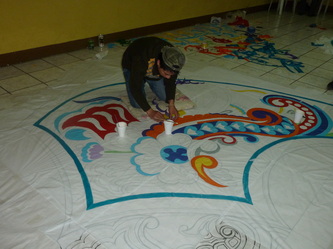
eyes how cut paper could look like a painting. I experienced the
largeness of a giant kite as I walked over it in my socks and looked down
on it’s Mayan stories and intricate design. I knew los barrileteros worked all night for many nights over many months to make this most fragile art of tissue paper.
But I still couldn't quite picture the process of making such an enormous and collaborative piece of art. So I was very happy when Julio told me he could arrange for me to watch a group of kitemakers at work on Saturday night andthat he would also
arrange for me to stay with a family in Sumpango so I would have a place to catch some sleep and to eat.

and generosity, even meeting me in Antigua to accompany me on the “chicken
buses” to Sumpango. I had never been there at night before --
many people were on the streets and the shops were
alight. Julio told me that the people of Sumpango loved “pan” (bread) and
that there were 10 panaderias in Sumpango, pointing three of them out while
we waited for the minivan which would take me to my homestay. I confessed
I thought that the Guatemalan panaderias made some of the best cookies
I had ever tasted. If you like crunch and a flavor that almost tastes
nutricious but still is totally a cookie, las champaradas, can’t be beat.
The homestay Julio took me to had a lovely garden and several detached buildings, including a tienda that sold a vast variety of goods. I had my own room and a double bed. The bathroom was modern and nearby . Sara cooked me eggs and frijoles for dinner and showed me pictures of her family. Then she gave me a tour of her tienda which sells food, medicine and even clothes. It was my first time on the other side of the counter!
Around 8:00 Julio came to collect me. I was also accompanied by Nataniel, one off Sara’s sons. We passed five evangelical churches as we walked,each with their doors wide open, ministers or musicians on microphones addressing audiences ranging from 5 to 50 people. Julio told me that several different groups of los barrileteros usually worked in the municipal building on Saturday nights. But as we approached we heard party music and Julio said there was a wedding in the municipal hall so most of the groups would not have a place to meet. But I should not worry, he said, because the group "Corazon Juvenil" would be there.

The flowing designs filled more than half the floor. The barrileteros said I could walk on it, without my shoes, to take a closer look. Each section so large that 5 people could lie down on each piece. And I was only looking at the outer design. The theme of the kite would occupy the center and they would work on that last, though it is the most complicated in design.
When I asked who the artist for the design was, Juan pointed to Rolando, a muscular and confident looking young man seated in a folding chair. When I said I would like to see how he had designed this kite, he un veiled an intricately drawn and colored mandala that was a miniature of the work I saw unfolded on the floor. It had taken hime three months to imagine and plan the design. “But I only worked one or two hours every day on this. I have a family – two children—and also I work.”
“What will go into the center?” I asked, “or can you tell me? I knew the design of these kites was kept a secret until November 1. He unfolded three small and striking pictures. He would draw them larger to fill the center and they too would be colored with paper.
Two Barrileteros began folding the completed sections of the design to put away while others taped a completed
section on the wall. The youngest members began taking sheaths of thin vibrantly colored tissue paper from
sacks. Their kite will use between 7000 and 8000 pieces of tissue paper. Each sheet is about 12 X 24.
Meanwhile two other barrileteros unrolled a large penciled design on manila paper. Then they began carefully laying delicate sheets of white tissue paper over the design, gluing each one to the other using small paintbrushes. They needed to use enough glue to adhere the paper completely, but not so much that the glue would bleed through and cause the tissue paper to stick to the desing below it. If the paper stuck, the tissue could tear and make a hole in the kite.
The young men at the table were already cutting their rainbow papers into assorted shapes which would fit into the
design like a jigsaw puzzle. Another man knelt over a nearly finished section of the design, tracing the missing parts.
While much of the gluing is done fitting the cut shapes exactly into thelines of the design below, assembling the entire design in this manner runs the risk of gluing the tissue paper to the design itself, so the design is removed and the missing shapes are drawn onto tissue paper to be filled in last.
Meanwhile Rolando selected a yellow oval as the first piece for this new section. He knelt on the tissue paper and applied glue carefully to all the edges with his tiny paint brush, smoothing the tissue carefully with his fingers.
places to find the exact fit. Each piece required the same careful gluing and perfect placement. I understood when Julio said that after awhile it was hard on his knees!
The group had worked for about 20 minutes when Juan let out a loud whoop which broke the trance of the delicate
work but did not interrupt it. The section the gluers were working grew very slowly and I wondered if I
would be bored even with Juan’s periodic yelps. And yet the work had the opposite effect on me, I was entranced with the care each piece of the design received and how perfectly to match the pieces were cut. With each added piece the design took on more life and I finally realized it was a mirror to the section taped on the wall.
After a couple hours, Rolando poured everyone a half glass of beer and Juan put a cassette into a tape player. But still each member of the group continued his work. “I feel good after this,” a barriletero said when I asked him how he could work so late in the night. The work required careful attention and was in this way a meditation. Yet it was strange and somehow comforting to see a group of men simply cutting tissue paper with scissors and then gluing the pieces on to the design.
“The week before November 1 we work every night,” the barriletero added. “I am very very tired when we are finished.” It
was almost one in the morning when I began to pity my escort Nataniel, who had fallen asleep several times in his folding chair. I had tried to make myself leave earlier on his behalf but the truth is that I wanted to stay and watch them working. It was somehow utterly captivating to watch the design emerge. But when Juan returned with a liter of
coca-cola, I knew it was time to leave.
There were only a few men on thestreets as we walked back to my hometay. I was still enchanted by the patient dedication of the barriletros. When I first was searching out barrileteros, I was eager to find women kitemakers. But this year the women’s group was not participating as the leader wasdealing with a troubled pregnancy and the women did not enjoy the same support
from their families as the men. I was disappointed and sad that the women were not able to participate as a group this year. Still, after watching the members of Corazon Juvenil , I couldn’t help but image that the world would be less violent and more sane if groups of men spent their time making giant kites from tissue paper.
In the morning, Sara’s husband Vincent served me atol (rice and wheat blended smooth with milk, cinnamon & sugar), bread and slices of watermelon and pineapple. Her son Audie, who had worked with Corazon Juvenil for two years before
beginning university in Guatemala City, was happy to show me his slides of the giant kites from the year before.
It seemed I could not get enough of looking at them. For I have fallen in love with these kites, for their beauty, for the largeness andmomentary burst of their vision, for the unending innovation in their designand for the dedication that goes into their making. Like the sand paintings of the Navaho and the mandalas of sand made by the monks of Tibet, the giant kites are a holy and temporary art .
PS. Check back for photos of Corozan Juvenil's kite after November 1. Or join me in Sumpango and see these amazing kites yourself!




















 RSS Feed
RSS Feed

